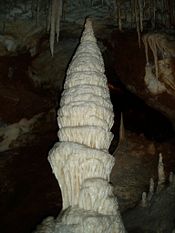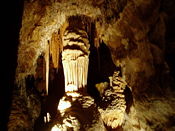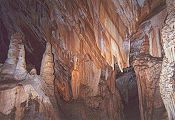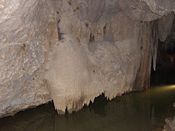Difference between revisions of "Greater Blue Mountains Area" - New World Encyclopedia
Mary Anglin (talk | contribs) |
Mary Anglin (talk | contribs) |
||
| Line 60: | Line 60: | ||
;Wollemi National Park | ;Wollemi National Park | ||
| + | Wollemi National Park contains the only known wild specimens of the [[Wollemi Pine]] (''Wollemia nobilis''), a species thought to have become extinct approximately thirty million years ago, but discovered alive in three small stands in 1994. [[Eucalyptus]] dominated open [[forest]]s comprise 90 percent of Wollemi, with over 70 species of Eucalypt recorded. The remaining 10 percent of the Park comprises [[rainforest]], [[heath]] and [[grassland]]. | ||
| + | |||
| + | There are many aboriginal sites within the park including [[cave painting]]s, axe grinding grooves and [[rock carving]]s. In 2003 the discovery of Eagle's Reach cave was publicly announced. This site was found by bushwalkers in 1995 but remained unknown to the wider community until a team from the [[Australian Museum]] reached the cave in May 2003. The art within this small cave is estimated to be up to 4,000 years old and it consists of up to a dozen layers of imagery depicting a wide variety of motifs rendered in ochre and charcoal. The team who recorded this site counted over 200 separate images, mainly of animals and birds but also stencils of hands, axes and a [[boomerang]]. | ||
| + | |||
| + | |||
| + | |||
| + | * James Woodford [http://www.smh.com.au/articles/2003/09/26/1064083186183.html Songlines across the Wollemi] ''The Sydney Morning Herald''. Retrieved September 2, 2008. | ||
;Yengo National Park | ;Yengo National Park | ||
Revision as of 23:44, 2 September 2008
| Greater Blue Mountains Area* | |
|---|---|
| UNESCO World Heritage Site | |
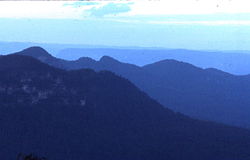
| |
| State Party | |
| Type | Natural |
| Criteria | ix, x |
| Reference | 917 |
| Region** | Asia-Pacific |
| Inscription history | |
| Inscription | 2000 (24th Session) |
| * Name as inscribed on World Heritage List. ** Region as classified by UNESCO. | |
The Greater Blue Mountains Area is a UNESCO World Heritage Site in the Blue Mountains of New South Wales, Australia. Forming a central part of the Great Dividing Range, it consists of eight individual protected areas covering more than one million hectares of rainforest, canyons, eucalypt forest and heath lands.
The Greater Blue Mountains Area is an area of rugged tablelands, sheer cliffs, deep, inaccessible valleys and rivers and lakes teeming with life. The unique plants and animals that live in this pristine highland relate an extraordinary story of Australia's antiquity, its diversity of life. This is the story of the evolution of Australia's unique eucalypt vegetation and its associated communities, plants and animals.
Description
The Greater Blue Mountains Area consists of 10,326 square kilometers (3987 sq mi) of mostly forested landscape on a sandstone plateau 60 to 180 kilometers (35 to 50 mi) inland from central Sydney. The area includes vast expanses of wilderness and is equivalent in area to almost one third of Belgium, or twice the size of Brunei.
The traditional owners of the Area — the Aboriginal peoples residing in the area before European influx — are the Darug, Gundungurra, Wanaruah, Wiradjuri, Darkinjung and Tharawal Nations.
The area takes its name from the predominant feature, the Blue Mountains. Originally named the "Carmarthen Hills" and "Landsdowne Hills" in 1788, the distinctive blue haze surrounding the hills prompted a name change. The bluish color is believed to be caused by fine droplets of oil dispersed into the air by the many types of indigenous eucalyptus trees. In combination with dust particles and water vapor, visible blue spectrum sunlight is more predominantly reflected from the landscape.
Though named "mountains", the area does not contain mountains in the conventional sense but is more correctly described as a deeply incised sandstone plateau rising from less than 100 meters above sea level to 1,300 meters (328 to 4265 feet) at the highest point. There are basalt outcrops on the higher ridges. This plateau is thought to have enabled the survival of a rich diversity of plant and animal life by providing a refuge from climatic changes during recent geological history. It is particularly noted for its wide and balanced representation of eucalypt habitats from wet and dry sclerophyll, mallee heathlands, as well as localized swamps, wetlands, and grassland. Ninety-one species of eucalyptus (thirteen percent of the global total) occur in the Greater Blue Mountains Area. Twelve of these are believed to occur only in the Sydney sandstone region.
The area has been described as a natural laboratory for studying the evolution of the eucalyptus. The largest area of high diversity of this plant on the continent is located in the southeast, with the Greater Blue Mountains Area containing much of this diversity.
As well as supporting such a significant proportion of the world's eucalyptus species, the area provides examples of the range of structural adaptations of the eucalyptus to Australian environments. These vary from tall forests at the margins of rainforest in the deep valleys, through open forests and woodlands, to shrublands of stunted mallees on the exposed tablelands.
In addition to its outstanding eucalyptus, the Greater Blue Mountains Area also contains ancient, relict species of global significance. The most famous of these is the recently-discovered Wollemi pine, a "living fossil" dating to the age of the dinosaurs. Thought to have been extinct for millions of years, the few surviving trees of this ancient species are known only from three small populations located in remote, inaccessible gorges within the area. The Wollemi pine is one of the world's rarest species.
More than 400 different kinds of animals live within the rugged gorges and tablelands of the Area. These include threatened or rare species of conservation significance, such as the Tiger Quoll, the koala, the Yellow-bellied Glider and the Long-nosed Potoroo as well as rare reptiles including the Green and Golden Bell Frog and the Blue Mountains water skink.
Protected areas
The Greater Blue Mountains Area consists of 1,032,649 hectares (2,551,731.25 acres) which includes eight protected areas in two blocks separated by a transportation and urban development corridor. It is made up of seven outstanding national parks as well as the famous Jenolan Caves Karst Conservation Reserve (2,422 ha). National parks include the Blue Mountains National Park (247,840 ha), Wollemi National Park (499,879 ha), Yengo National Park (153,483 ha), Nattai National Park (47,855 ha), Kanangra-Boyd National Park (65,379 ha), Gardens of Stone National Park (15,150 ha) and Thirlmere Lakes National Park (641 ha).
- Jenolan Caves
The Jenolan Caves are an example of remarkable caverns in the Blue Mountains. These caves attracts over 250,000 visitors a year, making it the most popular tourist location in rural New South Wales. They are the most celebrated of several similar groups in the limestone of the country and are believed to be the oldest discovered open caves in the world, estimated at approximately 340 million years old. They have not yielded fossils of great interest but the stalactitic formations, sometimes pure white, are of extraordinary beauty. Large portions of this extensive cave system are accessible only to cavers, especially those areas along the underground river system; but, there are ten caves at Jenolan that have been developed for regular tourism.
- Blue Mountains National Park
- Wollemi National Park
Wollemi National Park contains the only known wild specimens of the Wollemi Pine (Wollemia nobilis), a species thought to have become extinct approximately thirty million years ago, but discovered alive in three small stands in 1994. Eucalyptus dominated open forests comprise 90 percent of Wollemi, with over 70 species of Eucalypt recorded. The remaining 10 percent of the Park comprises rainforest, heath and grassland.
There are many aboriginal sites within the park including cave paintings, axe grinding grooves and rock carvings. In 2003 the discovery of Eagle's Reach cave was publicly announced. This site was found by bushwalkers in 1995 but remained unknown to the wider community until a team from the Australian Museum reached the cave in May 2003. The art within this small cave is estimated to be up to 4,000 years old and it consists of up to a dozen layers of imagery depicting a wide variety of motifs rendered in ochre and charcoal. The team who recorded this site counted over 200 separate images, mainly of animals and birds but also stencils of hands, axes and a boomerang.
- James Woodford Songlines across the Wollemi The Sydney Morning Herald. Retrieved September 2, 2008.
- Yengo National Park
- Nattai National Park
- Kanangra-Boyd National Park
- Gardens of Stone National Park
- Thirlmere Lakes National Park
ReferencesISBN links support NWE through referral fees
- Australia. 1999. Australia's world heritage. Canberra, ACT: Dept. of the Environment and Heritage. ISBN 9780642214317
- Australia. 1998. The greater Blue Mountains area: world heritage nomination. Canberra: NSW Parks and Wildlife Service in association with Environment Australia].
- UNESCO World Heritage Centre. Greater Blue Mountains Area Retrieved August 30, 2008.
- United Nations Environment Programme. The Greater Blue Mountains Area, New South Wales, Australia Retrieved August 30, 2008.
[3].
External links
- Blue Mountains World Heritage Institute. Blue Mountains World Heritage Institute Retrieved August 30, 2008.
- Stralia Web. Blue Mountains Retrieved August 30, 2008.
Credits
New World Encyclopedia writers and editors rewrote and completed the Wikipedia article in accordance with New World Encyclopedia standards. This article abides by terms of the Creative Commons CC-by-sa 3.0 License (CC-by-sa), which may be used and disseminated with proper attribution. Credit is due under the terms of this license that can reference both the New World Encyclopedia contributors and the selfless volunteer contributors of the Wikimedia Foundation. To cite this article click here for a list of acceptable citing formats.The history of earlier contributions by wikipedians is accessible to researchers here:
The history of this article since it was imported to New World Encyclopedia:
Note: Some restrictions may apply to use of individual images which are separately licensed.
- ↑ Staff writer. "Tests show Jenolan Caves among world's oldest", ABC News Online, Australian Broadcasting Corporation, 2006-07-25. Retrieved 2006-07-25.
- ↑ Colchester, D.M., Osborne, R.A.L., Pogson, R.E., Zwingmann, H., 2006, Carboniferous clay deposits from Jenolan Caves, New South Wales: implications for timing of speleogenesis and regional geology, Australian Journal of Earth Sciences, 53(3), p377-405
- ↑ "Jenolan Caves 340 million years old: study", CSIRO, 2006-07-25.
